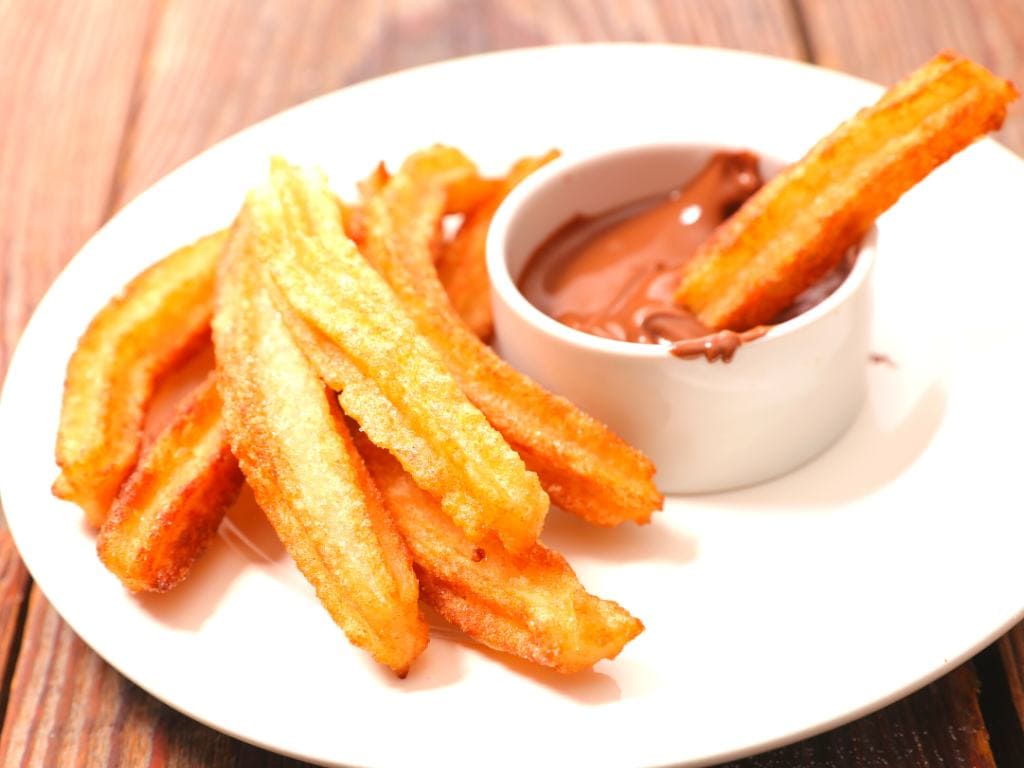What is Merienda in English? (+ 15 Spanish Snack Foods)
Disclaimer: Links on this page may be affiliate links. If you make a purchase after clicking a link, I may receive a small compensation to help power my site at no cost to you.
What is “merienda” in English? Learn all about Spain’s mid-afternoon snack and find some typical Spanish snacks, too!
Several years ago, when I was working at a summer camp in Spain, merienda was part of the daily itinerary. Having lived in Spain for a year at that point, I had already become quite accustomed to Spanish mealtimes—but the concept of merienda still alluded me.
I soon learned all about merienda in Spain—what merienda is, when and why Spanish people eat merienda, and (perhaps more importantly) what to eat for merienda!
To this end, you’ll want to know what merienda is in English so you can immerse yourself in Spanish culture on your next trip!
In this post, we’ll go over what merienda is English, its Spanish meaning and traditions surrounding it, and how to pronounce merienda. Plus, we’ll list 15 popular Spanish merienda ideas that will have you eating like a local in no time at all!
What is Merienda in English?

So, what is the meaning of merienda?
Merienda is Spain’s traditional afternoon snack. Meaning “light afternoon meal,” the merienda is eaten in the late afternoon or early evening—around 5-6:30 pm.
No, it’s not lost on Spaniards that 5-6:30 pm is dinner time in many countries. But, Spain has its own customs when it comes to mealtimes. In fact, the merienda is Spain’s fourth meal of the day! It follows two breakfasts (desyauno and almuerzo) and lunch (comida) and comes before dinner (cena), which isn’t until 9 or 10 pm.
While many tourists are ready to eat dinner around 5 or 6 pm, Spaniards head to cafeterías for the integral afternoon snack, or merienda. After all, they need to tide themselves over seeing as there could be as many as seven or eight hours between lunch and dinner!
But, you don’t have to go out for merienda meals. You can eat them at home or on the go. Additionally, not all adults have an afternoon snack. However, families with kids will most certainly serve a merienda of pastry, fruit, yogurt, or the like. In some parts of Spain, merienda refers almost exclusively to children.
Despite the complicated rules regarding Spanish mealtimes, the merienda is pretty simple. It can be a sweet or a savory snack, like a sandwich or pastry accompanied by a drink. We’ll review the most popular Spanish snacks in the section, below.
All in all, merienda is yet another time to sit back, relax, and enjoy time with friends and family around the table in Spain.
What Does Merienda Mean in Spanish?

Merienda is one of those words in Spanish that doesn’t quite have an English translation. The Real Academica Española (the institution in charge of the Spanish language) defines merienda as a “light meal that’s made in the afternoon before dinner.”
That being said, sometimes you’ll hear merienda translated to afternoon tea or tea time, especially by British people. (In fact, that’s the term we used at the English language immersion camp I worked at in Spain!)
There are several ways to use “merienda” in Spanish to describe having an afternoon snack. Let’s review them.
La merienda – Afternoon Snack (n)
The snack food or small meal itself is referred to as the merienda.
- What is your favorite snack? (¿Cuál es tu merienda favorita?)
La merienda – Snack Time (n)
When you’re talking about the gathering or afternoon snack time, you can use the noun merienda.
- The ladies are meeting up for snack time. (Las damas se reúnen para la merienda.)
Merendar – To Have a Snack in the Afternoon (v)
Use the verb form merendar to describe having a snack in the afternoon or to say, “to snack.”
The Real Academica Española (RAE) defines merendar roughly as “to eat something for snack time” or “to eat the snack.”
- The kids usually snack after tutoring. (Las niñas suelen merendar después de la tutoría.)
How Do You Pronounce Merienda in English?
The pronunciation of merienda is meh-ryehn-dah.
For more help, watch this video on how to pronounce merienda (afternoon snack) in Spanish. ⤵
The Origin of the Merienda in Spain

The word merienda comes from the Latin merenda, which means “to earn” or “to deserve.” The verb form merendar (to snack) comes from the verb merere (to deserve.)
The exact origins of the afternoon snack in Spain are up for debate.
However, it’s widely thought that a snack was eaten in the afternoon after having earned it—with origins back to the soldiers in Ancient Rome!
It’s interesting to note that in Galician, Italian, and Portuguese the word merenda is the same as in Latin (merenda meaning snack in all languages) whereas in Spanish it changed to merienda.
15 Popular Spanish Merienda Ideas

The merienda is a fundamental part of daily life that many Spaniards have been doing since childhood. In the past, Spaniards ate lots of bread for their merienda food like bocadillos, chocolate napolitanas, or toast. Today, the best merienda options are more varied.
Regional differences in the merienda should also be expected.
In any case, here’s a list of the most typical Spanish merienda ideas you can plan to eat when traveling.
1. Cakes & Cookies – Bizcochos
Bizcochos in the Spanish-speaking world refer to a wide range of pastries, cakes, or cookies. In Spain, the traditional bizcochos are light and airy sponge cakes baked with that come in a variety of flavors like lemon, chocolate, and apple.
Whether it’s a bizcocho or other type of regional cake like a Tarta de Santiago in Galicia, these treats make for a delicious merienda along with coffee or a hot beverage!
2. Coffee – Café
Coffee is a great pick-me-up in the afternoon. Besides, it tastes good alone or with both sweet and savory snacks. Go out to a café with a friend, or opt for a homemade coffee.
3. Yogurt – Yogur
Yogurt is a common snack food in Spain, especially at home. It’s also popular after lunch or dinner in place of a sweet dessert. Yogurt is very inexpensive at Spanish grocery stores.
4. Fresh Fruit – Fruta
Seasonal fruit is a healthy and affordable snack in Spain that you can buy at any grocery store. Sometimes, you’ll find it on the menu at cafeterías for dessert, too.
5. Pastries – Pasteles
Spanish pastries (sweet or savory) are an excellent option for a merienda along with coffee or tea. Choose from napolitanas (chocolate croissants), ensaimadas (traditional sweet pastry from Mallorca) or various regional specialties all across Spain.

6. Sandwiches – Bocadillos
Spanish sandwiches are one of the most well-known foods in Spain. A bocadillo de jamón (cured ham and cheese on baguette-style bread) is the most famous sandwich in Spain, but you can find various fillings and types of bread from ham to sardines to Spanish tortilla (egg and potato omelet).
7. Cured Meat – Embutidos
Spain is known for its cured meat, and merienda is as good of a time as any to partake! Most embutidos are made from pork such as jamón, chorizo, or salchichón, though beef can be found in some regions like in the north. Pair cured meat with bread or Spanish cheese for a mouth-watering merienda.
8. Cheese – Queso
Although not as well known as France or Italy, Spain’s cheese is out of this world! From raw cow’s milk in Arzúa or cured Manchego from sheep’s milk, Spanish cheese makes for a protein-filled afternoon snack that’s easy to prepare.
9. Olives – Aceitunas
Olives are the perfect healthy snack to fuel your brain and body in the late afternoon. And, since Spain has nearly 300 varieties of olives, they’re very easy to find on any merienda menu!
10. Churros with Chocolate – Churros con chocolate
One of the best-known Spanish snack foods is Spain’s most famous street food, churros. Churros are made of dough fried into long sticks, much like Americans will find at carnivals.
Churros are particularly popular in Madrid, where they are served with a hot dipping chocolate for breakfast or merienda, but never for dessert!

11. Salads – Ensaladas
Salads make a good afternoon snack (and lunch and supper, for that matter). And, not just lettuce salads. You will find a variety of olive oil and mayonnaise-based salads in Spain. Seafood or tuna salads are particularly yummy for a quick snack.
12. Milk – Leche
If you’re not all that hungry, a glass of cold milk makes a good afternoon merienda.
13. Eggs – Huevos
Eggs are an excellent source of protein and an easy to cook merienda. If you’re eating at home, consider frying an egg for the merienda. Hard-boiled eggs, made in advance, are also a good option.
14. Shake – Batido
Shakes made of fruit or freshly squeezed juices are popular in Spain and offer a kick of energy between meals.
15. Oats – Avena
A quick porridge of oats with fruit or nuts makes a simple and healthy snack at home. This merienda is easy to make as well!
Some Useful Spanish Expressions Associate With Merienda
You may be surprised to hear that there are even more phrases related to the word merienda in Spanish:
✔ to snack — merendar
✔ healthy snacks — meriendas saludables
✔ cheap snacks — meriendas baratos
✔ snack recipes — recetas de meriendas
✔ Do you want something to snack on? — ¿Quieres algo de merendar?
✔ high tea — merienda cena
✔ to go for Spanish afternoon snack — ir de merienda
✔ to join forces — juntar meriendas
✔ to thrash or defeat — merendarse a alguien
✔ free-for-all, shady arrangement, fix — merienda de negros
✔ packed meal — merienda (de viaje)
✔ picnic — merienda al campo, merienda campestre, merienda al aire libre
✔ snack bag — bolsa merienda
✔ tea party — fiesta del té
Merienda Meaning FAQ’s
Is it merienda or tapas?
Merienda is a light meal eaten in the late afternoon, whereas tapas are typically eaten for lunch or dinner. Tapas are small plates or bites of food that are meant to be shared between everyone at the table. While some merienda food and tapas overlap (like cured meats and cheese), the time of day and setting in which they are eaten differ.
When would a Spanish person have a merienda?
There’s no official time for the Spanish afternoon snack. It can technically be eaten any time after lunch and before dinner! Nevertheless, most people in Spain eat merienda between 5 and 6:30 pm.
Which countries eat merienda?
Several Southern European countries eat merienda such as Spain, Portugal, and Italy. In addition, Spanish-speaking countries like Argentina, Uruguay, Bolivia, Cuba, the Dominican Republic, Colombia, Chile, and Venezuela have some sort of drink or snack which some equate to “British tea time.” A few other countries also eat the merienda such as the Philippines (where rice and viand is popular), Brazil, Morocco, and France. The time of day, what is eaten, and who eats (adults and/or kids) varies between cultures.
What are the Spanish mealtimes?
Here are the mealtimes observed in Spain:
- Desayuno (First breakfast) — upon waking, as early as 7 am
- Almuerzo (Second breakfast/Mid-morning snack) — 10 am–11 am
- Comida (Lunch) — 2–3:30 pm
- Merienda (The light food that is eaten in the afternoon-evening) — 5–7 pm
- Cena (Dinner, the evening meal) — 8 pm-midnight
What are the two snack times called in Spain?
The two snack times in Spain are the almuerzo (mid-morning snack) from roughly 10 am to 11 am and the merienda (mid-afternoon snack) from about 5 pm to 6 pm.
Conclusion: What is Merienda?

In conclusion, eating merienda in Spain is nuanced!
If you’re traveling or living in a Spanish-speaking country, you’ll want to learn how to experience the merienda—whether you’re trying to invite a Spanish friend for a light meal, eating alone at a cafetería, or preparing snacks at home.
Fortunately for you, you’ve taken the first step by reviewing this blog post all about la merienda en España. Feel free to reference it any time you think about picking up a Spanish – English dictionary to review what the merienda is!
¡Buen provecho!
